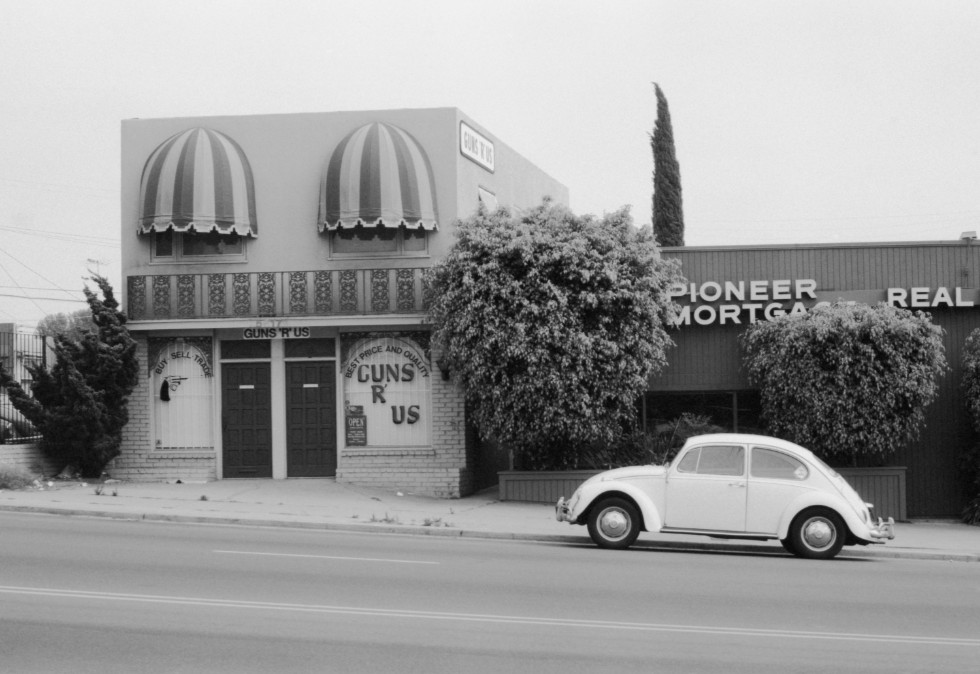Truth and Memory: Stephen Clarke – San Diego Topographics

How do we separate truth from memory? Should we try? A pair of recently published photo books from Stephen Clarke poses intriguing questions about the passage of time, finds Mike Pinnington…
Time does strange things. In the moment, as that phrase suggests, its impact is imperceptible. At a distance, with hindsight – that is when the passage of time does its work and its effects are felt most keenly. Things look and can be perceived differently. How do we separate the truth from false memories? Should we? Does it matter? These questions make their presence felt in a pair of new photography books by Stephen Clarke, recently published by Café Royal. San Diego Topogrqaphics 1 and San Diego Topographics 2 1986–1987 span a year or so in the life of the photographer. Or, rather, the particular urban landscape in which he found himself as the Cold War and the century to which it belonged was petering out. It is a far cry from the surrounds of Newport, Wales, where he’d just completed his undergraduate studies in Fine Art.
At a loss on where to undertake his MA, Clarke found himself in Southern California. And, as these collections’ titles denote, his photography of this period refers and responds to the New Topographics movement, which had its beginnings in mid-1970s America. It found its way to the UK in the early 80s, says Clarke, “through the efforts of Jem Southam and Paul Graham”. In keeping with the objective, formalist approach which defines it, when I asked him about his relationship to NT, he replied: “I’m a cold practitioner; not an emotive photographer.” And, certainly, the images in these collections are faithful to the quotidian, largely urban subject matter found in the work of key figures of the movement such as Robert Adams, Lewis Baltz and Joe Deal.
On the cover of Topographics 1, for instance, cars parked almost bumper-to-bumper snake round the undulating rise of an asphalt bend, telegraph wires drooping lazily overhead. The make and models of the cars – a couple of Volkswagen Beetles take centre-stage – lends an almost ageless quality to the scene. Elsewhere, on a beach, an incongruous wire fence manages to obscure the beauty of the ocean; its curve, demarcating the elemental and the human, attracts weeds. Any images that indulge nature more prominently tend to the uncanny: in the centre spread, a throng of palm trees straight out of folk horror loom ominously (their progress, prosaically tempered by a bike route). Wildlife is similarly stymied and features either at the remove or in the confines of the San Diego Zoo or, robbed of feral energy, is fabricated. In one photograph, a sculpture of a prancing white horse rears up precariously. It stands atop a flimsy-looking platform, its purpose unclear. Humans, when they appear, fare no better. At leisure and in clusters, they seem passive. Not really there – like pack animals after a feed. Or on Valium.

No such concessions – however limited – are made to either human or animal in Topographics 2, where presence is suggested only by its conspicuous absence: a sports stadium standing empty conjures the concussive jolts of clashing American Football helmets and ghostly echoes of cheerleaders chanting; bins on the sidewalk huddle together, plotting who knows what; a static car, meanwhile, is swaddled in plastic sheeting to protect it from the corrosive rays of the sun. The irony. Man’s usually detrimental influence is never far away. A couple of photographs featuring satellite dishes hidden in plain sight, are evocative of Reagan’s Strategic Defense Initiative. More explicitly present in the series is that particular combination of awe and displacement one can feel when visiting North America for the first time. “In San Diego I wasn’t aware of the heat,” says Clarke. “What I was aware of,” he continues, “is the horizontal landscape – it stretched out.” His photographs capture and suggest this time and again, in the sprawl of San Diego’s burgeoning and parched-looking downtown (above) and freeway cityscapes.
Accumulating more than one hundred rolls of 35mm black and white film in just over twelve months, Clarke says that, as he waited until he got home to process them, he was “shooting blind… not knowing what I had got.” Not all of what he shot makes it into the Café Royal publications, but there’s little fat here. One such image (top) features what looks to be a classic example of the US mom-and-pop store in a quaint two-storey building. What is remarkable about the business is its name: Guns ‘R’ Us. It is a scene so anachronistic it has to be seen to be believed; yet, my guess is that the US will be littered with such outlets today. In another, we see a church hoarding in a gas station forecourt, advertising ‘God’s Greatest Gift: Jesus Our Savior’. Religious piety and fossil fuel-driven economy juxtaposed in a single image, which foreshadows today’s unhappy marriage of Christianity and climate change denial.
Viewed through the lens of 2020 – thus imbued with an elusive and allusive quality (that, perhaps, ultimately only the passage of time can bestow) – these pictures are more than mere documents of the specificities of place. The intervening years mean that they are drenched with nostalgia, lost youth and dreams of an earlier generation’s future. As Clarke has said, “I am ‘having a conversation’ with my twenty-four-year-old self!” As such, these photographs are shot through with feeling today. They practically vibrate with an elegiac quality so that, when I picture them in my mind’s eye, they appear in sepia.
Mike Pinnington
All images, from top, © Stephen Clarke: Guns R Us (1987); San Diego Downtown (1987); homepage/banner: UCSD Library (1987)
The San Diego Topographics Series by Stephen Clarke is available from Café Royal Books. Stephen’s work is currently on display at Contemporary Art Space Chester





